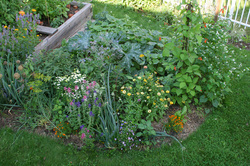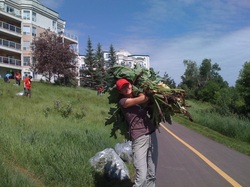
I like how well the zucchini, cucumbers, and onions are growing. I also started some flowers from seed to attract pollinators, including pot marigold, salvia, fewerfew (supposed to be good for headaches), dill, cilantro, runner beans and buckwheat. The two honeyberry / haskap bushes are also doing well, though I'm keeping my eye on possible mildew with all that rain again this year.
Some Swiss Chard ended up in the bed by accident. Compared to the other chard in the raised bed just half a metre away, this plant is noticeably bigger. I tested it with the Brix meter, and the sugar levels are higher. This could be because of more favorable nutrients, and also because of the consistent moisture in the sheet mulch. In the fall, I plan on layering garden waste, compost and leaves to top up the organic matter. So far, this bed has been surpassed my expectations!

 RSS Feed
RSS Feed